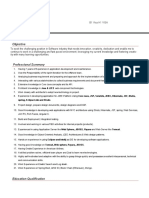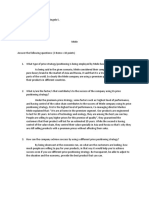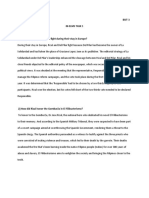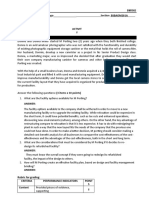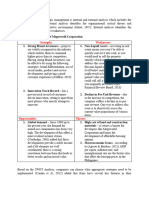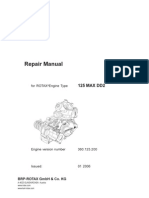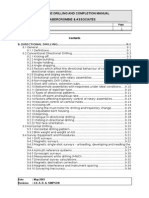Professional Documents
Culture Documents
09 Activity 1
09 Activity 1
Uploaded by
Jhead Tristine EncinaOriginal Description:
Original Title
Copyright
Available Formats
Share this document
Did you find this document useful?
Is this content inappropriate?
Report this DocumentCopyright:
Available Formats
09 Activity 1
09 Activity 1
Uploaded by
Jhead Tristine EncinaCopyright:
Available Formats
BM1902
Names _______________________________________________ Section ___________Date___________
ACTIVITY
Insourcing at GE: The Real Story
General Electric’s (GE) “insourcing” of appliance manufacturing to the U.S. has been trumpeted as a major
reversal of the trend of sending jobs abroad to lower cost locations, and has been characterized in the press
as a kind of “onshoring” story. First, a little relevant history: In the 1950s economic expansion drove growing
demand for appliances. To meet this demand, GE created GE Appliance Park in Louisville, Kentucky, which
reached a peak of 23,000 employees in 1973. In the early 2000s, as part of a huge offshoring trend in the
business economy, GE shifted manufacturing to suppliers such as Samsung and LG. But these suppliers became
competitors and ever-harder to work with. Then at the end of 2007, the housing market crashed. By the
summer of 2008 GE leadership wanted to sell the appliances business or spin it off.
During that difficult time, Dirk Bowman, former GE Appliances General Manager of Manufacturing, went to
GE Chairman Jeff Immelt with a proposal. Bowman aimed to increase manufacturing capability and bring
manufacturing jobs back to the U.S. from Korea, China, and Mexico. Immelt asked why production should be
put in old factories in a union environment. Dirk’s answer was: “We can save on transportation and be closer
to our customers. We can have engineering work more closely with production. We can work smarter than
Korea, China, and Mexico, using 15-20% of the labor they use.” Immelt was convinced, and GE Appliances
engage in a $1 billion or 50-billion-peso investment.
The challenges GE faced were daunting. If the goal was to leapfrog the competition in every product line while
revitalizing U.S. manufacturing, management had to take a big swing. The investment plan envisioned 11 new
product platforms in six (6) different manufacturing sites. The workplace was divided into functional areas; no
one knew how to work together. All the laboratory equipment had been given away. The only people left were
tough survivors, so the bench was not deep. The company needed to rebuild expertise and capabilities. It
needed to recruit huge numbers of people in a short period of time. It needed to invest in new development
labs and to co-locate teams.
In the summer of 2009, management decided to bring production of a water heater back to the U.S. from an
Asian contractor. In connection, the company introduced a new cross-functional team structure for
improvement which they call the “Big Room”. Managers seated together with a common goal to work on the
value stream from consumer research to testing. They put the schedule up on the wall so everybody knew
what was happening. There was a diagram of the production flow and a cardboard mockup of the factory
layout which also showed how the equipment would look. At 7:45 a.m. each day leaders met, then at 8:00
a.m. everyone met to review the prior day, and what they would do that day. Then at 4:15 p.m. everyone met
again to review what they’d done. The water heater that resulted was a new design, with better performance:
20% fewer parts and 50% less labor. Inventory was reduced 60%, labor efficiency improved 30%, time-to-
produce was reduced 68%, and space required for the line came down by 80%.
Answer the following: (3 items x 10 points)
1. Describe the internal and external customers of GE involved in the given case study.
2. Identify the advantages and disadvantages of the insourcing decision of GE relevant its company
operations.
3. Explain how GE managed to implement its insourcing decision successfully.
09 Activity 1 *Property of STI
Page 1 of 2
BM1902
Names _______________________________________________ Section ___________Date___________
Rubric for grading:
CRITERIA PERFORMANCE INDICATORS POINTS
Content Provided pieces of evidence, supporting
8
details, and factual scenarios
Grammar Used correct grammar, punctuation,
1
spelling, and capitalization
Organization Expressed the points in clear and logical
1
of ideas arrangement of ideas in the paragraph
TOTAL 10
Reference:
Power, B. (2013). Insourcing at GE: The real story. Retrieved June 3, 2019, from
https://hbr.org/2013/07/insourcing-at-ge-the-real-stor.
09 Activity 1 *Property of STI
Page 2 of 2
You might also like
- LightSpeed 2.X System Service ManualDocument1,018 pagesLightSpeed 2.X System Service Manuallncoll100% (13)
- MCI Finds Culture Shock CaseDocument6 pagesMCI Finds Culture Shock CaseErna Apostol Arcoseba60% (5)
- D D / Number of Working Days in A Year 10,000 / 300 33.33 Units Per DayDocument2 pagesD D / Number of Working Days in A Year 10,000 / 300 33.33 Units Per Daymichaelabatralo100% (2)
- Logistics Batingan1Document2 pagesLogistics Batingan1BeyaNoch keine Bewertungen
- BSMT Review For BoardsDocument3 pagesBSMT Review For BoardsLyudmyla GillegoNoch keine Bewertungen
- Dice Resume CV Venu KodamDocument6 pagesDice Resume CV Venu KodamkavinNoch keine Bewertungen
- General Electric CaseDocument8 pagesGeneral Electric CaseTruong Le quang0% (1)
- Facebook, Inc.: Bsba-3A Group 3Document27 pagesFacebook, Inc.: Bsba-3A Group 3sein sein100% (1)
- 11 Activity 2 CPDocument1 page11 Activity 2 CParisuNoch keine Bewertungen
- Activity 09 Under Warehouse Management Best Practices (H&M Company)Document1 pageActivity 09 Under Warehouse Management Best Practices (H&M Company)Sol TatakNoch keine Bewertungen
- 11 Activity 1 CPDocument2 pages11 Activity 1 CParisuNoch keine Bewertungen
- 06 Activity 1Document2 pages06 Activity 1mike ApostolNoch keine Bewertungen
- Answer The Following Items: (3 Items N 10 Poines)Document1 pageAnswer The Following Items: (3 Items N 10 Poines)Sol Tatak100% (1)
- AAfiya Individual Network ListDocument15 pagesAAfiya Individual Network ListAfra Fathima0% (2)
- 02 Activity 1 - 2Document1 page02 Activity 1 - 2Mabeth CajayonNoch keine Bewertungen
- LEGODocument2 pagesLEGOJohn Clark RosalesNoch keine Bewertungen
- Facility-Perez M.Document2 pagesFacility-Perez M.Marnelli Perez100% (1)
- 06 Worksheet 1 - ARG-GGSR-PONCEDocument2 pages06 Worksheet 1 - ARG-GGSR-PONCEVon Marvic PonceNoch keine Bewertungen
- Required: A. Break-Even Point in Units BEP in Units : Total Cost CM Per UnitDocument3 pagesRequired: A. Break-Even Point in Units BEP in Units : Total Cost CM Per UnitarisuNoch keine Bewertungen
- Dahunan, Ken Alvin H. BSBA 311 FACIMAN Activity 9Document1 pageDahunan, Ken Alvin H. BSBA 311 FACIMAN Activity 9ken dahunanNoch keine Bewertungen
- 03 Task Performance 1 (3) ENVDocument2 pages03 Task Performance 1 (3) ENVRalph Louise PoncianoNoch keine Bewertungen
- Case Study: Which Approach Is Best?Document2 pagesCase Study: Which Approach Is Best?Eurica CabilunaNoch keine Bewertungen
- Facmann MCIIDocument12 pagesFacmann MCIIMondemamon Mamon100% (2)
- 04activity2 Logistics FedexDocument2 pages04activity2 Logistics FedexBeyaNoch keine Bewertungen
- 03 Activity 1abdaopdfDocument1 page03 Activity 1abdaopdfRianna CclNoch keine Bewertungen
- Case Analysis. (20 Points: 4 Items X 5 Points)Document2 pagesCase Analysis. (20 Points: 4 Items X 5 Points)Gabriel TantiongcoNoch keine Bewertungen
- Aira Krish MoreteDocument2 pagesAira Krish MoreteAira Krisha100% (1)
- This Study Resource WasDocument1 pageThis Study Resource WasEskwelaSeryeNoch keine Bewertungen
- 3 Models TEM ActivityDocument1 page3 Models TEM ActivityAdrian PanganNoch keine Bewertungen
- Name: Jomari C. Rostan DateDocument2 pagesName: Jomari C. Rostan DateJomari RostanNoch keine Bewertungen
- ActivityDocument1 pageActivityCastillo EmmieNoch keine Bewertungen
- Activity 3 Case AnalysisDocument1 pageActivity 3 Case AnalysisShiella Mae BendecioNoch keine Bewertungen
- 11 QUIZ 1 Answer The Following Questions Based On The Given Scenario. (5 Items X 5 Points)Document1 page11 QUIZ 1 Answer The Following Questions Based On The Given Scenario. (5 Items X 5 Points)Princess Mae Saraza100% (1)
- 01 Activity 1 - ARG: Facility Management Concepcion, Stephanie Kyle S. BM303Document2 pages01 Activity 1 - ARG: Facility Management Concepcion, Stephanie Kyle S. BM303Stephanie Kyle Concepcion100% (3)
- TaskDocument1 pageTaskIrish Mendoza100% (2)
- Two Countries - Great Britain and The United StatesDocument1 pageTwo Countries - Great Britain and The United StatesYan TagleNoch keine Bewertungen
- Answer The Questions and Submit Thru Dropbox.: Case Analysis. (15 Points: 3 Items X 5 Points)Document2 pagesAnswer The Questions and Submit Thru Dropbox.: Case Analysis. (15 Points: 3 Items X 5 Points)Gabriel TantiongcoNoch keine Bewertungen
- ActivitieszzsxszsxsDocument4 pagesActivitieszzsxszsxsLeeyo100% (1)
- EM 08 eLMS Act 2Document1 pageEM 08 eLMS Act 2Christine Joy NatividadNoch keine Bewertungen
- Vienes, Jose Miguel C. Ms. Maria Felisa Calicdan BSBA-323 02 eLMS Review 1Document3 pagesVienes, Jose Miguel C. Ms. Maria Felisa Calicdan BSBA-323 02 eLMS Review 1Miguel VienesNoch keine Bewertungen
- TED TALK Manoush ZomorodiDocument2 pagesTED TALK Manoush ZomorodiCaine Valerian100% (1)
- Rom Corporation's Electricity Cost and Machine HoursDocument1 pageRom Corporation's Electricity Cost and Machine HoursBetchang AquinoNoch keine Bewertungen
- Case Study: A Challenge For Quality: ActivityDocument2 pagesCase Study: A Challenge For Quality: ActivityCristopher Rico Delgado100% (2)
- 06 ELMS TASK1 JaspherTamposDocument1 page06 ELMS TASK1 JaspherTamposJaspher Tampos100% (1)
- Case Analysis - 03 Activity 1Document1 pageCase Analysis - 03 Activity 1BeyaNoch keine Bewertungen
- 08 Task PerformanceDocument3 pages08 Task PerformanceBetchang AquinoNoch keine Bewertungen
- Hard To Imagine SUMMARY (Maximum of Seven (7) Sentences)Document2 pagesHard To Imagine SUMMARY (Maximum of Seven (7) Sentences)qweinna rtyuiop100% (1)
- 04 Activity 1 EMS SenisRachelDocument4 pages04 Activity 1 EMS SenisRachelRachel SenisNoch keine Bewertungen
- Activity ObliConDocument1 pageActivity ObliConKaye HernandezNoch keine Bewertungen
- Jose Miguel Vienes Mr. Pascual Abrazaldo BSBA-311: Differentiate Quality and Traditional CultureDocument2 pagesJose Miguel Vienes Mr. Pascual Abrazaldo BSBA-311: Differentiate Quality and Traditional CultureMiguel VienesNoch keine Bewertungen
- 04 eLMS Activity 1Document2 pages04 eLMS Activity 1Eyna Marie Jamandre LogronioNoch keine Bewertungen
- Idea Builder CATILO, AlexisDocument2 pagesIdea Builder CATILO, AlexisPercy Jason BustamanteNoch keine Bewertungen
- William and Harry Obliged Themselves To Deliver To Elizabeth A BulletDocument1 pageWilliam and Harry Obliged Themselves To Deliver To Elizabeth A BulletKenji CruzNoch keine Bewertungen
- Hard To Imagine SUMMARY (Maximum of Seven (7) Sentences)Document2 pagesHard To Imagine SUMMARY (Maximum of Seven (7) Sentences)qweinna rtyuiopNoch keine Bewertungen
- 05 Activity 1 13 AnswerDocument7 pages05 Activity 1 13 AnswerAllyza RenoballesNoch keine Bewertungen
- Great Books 03 eLMS Activity 2 (ESSAY) - ARG InstructionsDocument2 pagesGreat Books 03 eLMS Activity 2 (ESSAY) - ARG InstructionsSofia Riche BarriosNoch keine Bewertungen
- Case Analysis.: Property of STIDocument1 pageCase Analysis.: Property of STILIBREA, Aira Mae C.Noch keine Bewertungen
- The Life of An Iphone (Antonia, 2020) : Names Vless Butista Section Date ActivityDocument4 pagesThe Life of An Iphone (Antonia, 2020) : Names Vless Butista Section Date ActivityJanine CalditoNoch keine Bewertungen
- 06 eLMS Quiz 1 - ARGDocument1 page06 eLMS Quiz 1 - ARGLacorte Jr MeranoNoch keine Bewertungen
- AnswerDocument2 pagesAnswerAljean Kaye BalogoNoch keine Bewertungen
- 07 Activity 1Document2 pages07 Activity 1Grace AspirasNoch keine Bewertungen
- STRM043 Competitive Strategy & Innovation Anil Kumar Ganessen Chinnapen Adrian Pryce 16444036 2900 GE Case StudyDocument20 pagesSTRM043 Competitive Strategy & Innovation Anil Kumar Ganessen Chinnapen Adrian Pryce 16444036 2900 GE Case StudyXimena Lucero Gutierrez HurtadoNoch keine Bewertungen
- Deliverable 2Document4 pagesDeliverable 2assignmentsacerNoch keine Bewertungen
- Module 3.2 Learning Activity 1 Assessment 2 Discussion Forum Topic 2Document2 pagesModule 3.2 Learning Activity 1 Assessment 2 Discussion Forum Topic 2Aldryn Jude NicdaoNoch keine Bewertungen
- Tarka-Sangraha, Translation - Annam BhattaDocument571 pagesTarka-Sangraha, Translation - Annam BhattaShishirNoch keine Bewertungen
- Softball Pitching StylesDocument14 pagesSoftball Pitching StylesAlvin Charles LopezNoch keine Bewertungen
- Manufacture of Urea - Melamine - Formaldehyde Glue Used For Laminated Veneer Lumber ProductionDocument7 pagesManufacture of Urea - Melamine - Formaldehyde Glue Used For Laminated Veneer Lumber ProductionPhan KhánhNoch keine Bewertungen
- Caterpillar Cat 324d LN Excavator Prefix TRH Service Repair Manual trh00001 and Up 1616111112Document29 pagesCaterpillar Cat 324d LN Excavator Prefix TRH Service Repair Manual trh00001 and Up 1616111112Ali EndrisNoch keine Bewertungen
- Ce 3003 Steel Kac Lecture Notes - 2020-2021 - AnnotatedDocument109 pagesCe 3003 Steel Kac Lecture Notes - 2020-2021 - AnnotatedMannyNoch keine Bewertungen
- Acs Step-By-step Guide To Manuscript SubmissionDocument15 pagesAcs Step-By-step Guide To Manuscript SubmissionAnkit KumarNoch keine Bewertungen
- Rotax 125 Max dd2Document62 pagesRotax 125 Max dd2Jorge GonzalezNoch keine Bewertungen
- Annotated BibliographyDocument3 pagesAnnotated Bibliographyapi-242128397Noch keine Bewertungen
- HistoryDocument343 pagesHistoryKaruna MaharajNoch keine Bewertungen
- L'ACCÈS Internationale Co.: Internship ReportDocument27 pagesL'ACCÈS Internationale Co.: Internship ReportAyesha awanNoch keine Bewertungen
- Comparing Bible Translations Analysis 2 - Web - Archive.org Web 20071027015110 HTTP Faith - PropadeuDocument11 pagesComparing Bible Translations Analysis 2 - Web - Archive.org Web 20071027015110 HTTP Faith - PropadeuTed Dusablon Jr.Noch keine Bewertungen
- Dura-Line XD 14 and XD 14: Robust, Cost-Efficient, Wireless Flat Panel DetectorDocument4 pagesDura-Line XD 14 and XD 14: Robust, Cost-Efficient, Wireless Flat Panel DetectorEllan Pessoa100% (2)
- Chapter 9 Directional DrillingDocument49 pagesChapter 9 Directional DrillingKolawole AdisaNoch keine Bewertungen
- Writing A Proposal: This Is One of The Core Assignments, A Part of The Independent Research PortfolioDocument11 pagesWriting A Proposal: This Is One of The Core Assignments, A Part of The Independent Research PortfolioBasma A. Khaleq El-ShimyNoch keine Bewertungen
- Textbook Sige Based Re Engineering of Electronic Warfare Subsystems 1St Edition Wynand Lambrechts Ebook All Chapter PDFDocument53 pagesTextbook Sige Based Re Engineering of Electronic Warfare Subsystems 1St Edition Wynand Lambrechts Ebook All Chapter PDFherman.ryan834100% (6)
- United States Patent (191: Gardiner Et AlDocument7 pagesUnited States Patent (191: Gardiner Et Alvzimak2355Noch keine Bewertungen
- Language and Skills Test 6 KeyDocument2 pagesLanguage and Skills Test 6 KeylebanesefreeNoch keine Bewertungen
- Number 1 Module (Physical Education)Document3 pagesNumber 1 Module (Physical Education)Khimm TamiaoNoch keine Bewertungen
- Cara Import Meteo Data From Different SourceDocument4 pagesCara Import Meteo Data From Different SourceKania ZahrawatiNoch keine Bewertungen
- Using Machine Learning To Improve The Prediction of Functional Outcome in Ischemic Stroke PatientsDocument7 pagesUsing Machine Learning To Improve The Prediction of Functional Outcome in Ischemic Stroke PatientsdarNoch keine Bewertungen
- HP Product Warranty Results Victus by HP 16.1 Inch Gaming Laptop PC 16-E0000 (2V8Z6AV) - HP® Customer SupportDocument3 pagesHP Product Warranty Results Victus by HP 16.1 Inch Gaming Laptop PC 16-E0000 (2V8Z6AV) - HP® Customer Supportkyubi xxxNoch keine Bewertungen
- Module-5 3rd-Day Coordinating-Conjunctions Semi DetailedDocument3 pagesModule-5 3rd-Day Coordinating-Conjunctions Semi DetailedMaria Angela EduardoNoch keine Bewertungen
- Differences in Culture: International BusinessDocument19 pagesDifferences in Culture: International Businesssonia_hun885443Noch keine Bewertungen
- Dissonance and Dissent Chico Buarque DraDocument14 pagesDissonance and Dissent Chico Buarque Drajoshua.holme1Noch keine Bewertungen
- Siemens - Logo - Equinox Training SolutionsDocument2 pagesSiemens - Logo - Equinox Training SolutionsYathurshanNoch keine Bewertungen





